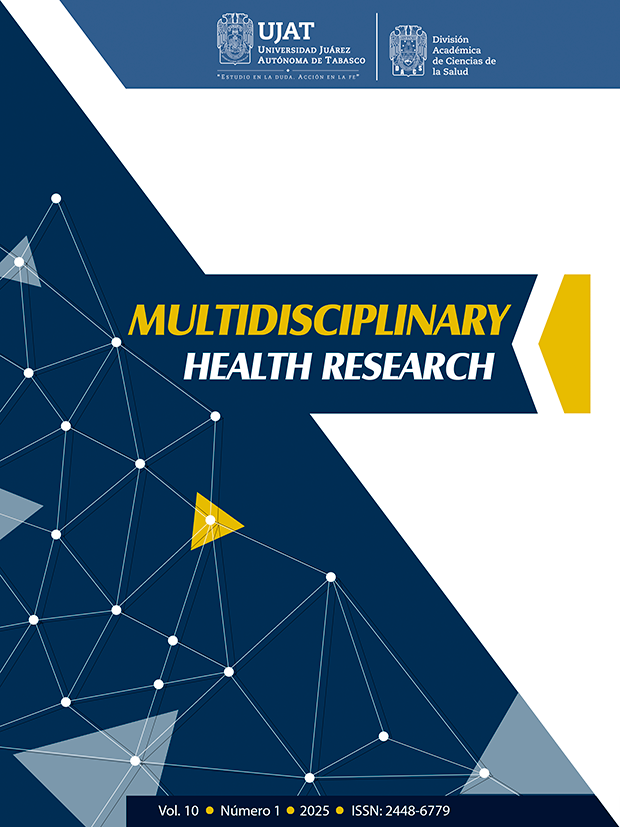Risk of malnutrition in older adults in the municipality of Centro, Tabasco.
DOI:
https://doi.org/10.19136/khvao8765mnetKeywords:
Older adults, Nutritional Status, MalnutritionAbstract
In Mexico, according to ENSANUT 2023; 6.9% of the elderly population is malnourished and worldwide, this population group has a high prevalence of malnutrition. Objective: To determine the risk of malnutrition in functional older adults in the municipality of Centro, Tabasco. Type of design: An observational, prospective, cross-sectional study was conducted. The study universe was made up of 218 functional older adults, a non-probabilistic sample was carried out for convenience. Inclusion criteria: Older adults who work as volunteer packers at the Soriana store, Hiper Plaza Deportiva, in Villahermosa Tabasco, regardless of gender or age or marital status. Results: 103 older adults studied, 50.5% (52) men and 49.5% (51 women. Regarding the assessment with Guigoz's Mini Nutritional Assessment (MNA), to assess the risk of malnutrition in the elderly, a minimum value of 14 points was obtained with a percentage of 3.9% (4) and a maximum value of 28 with a percentage of 2.9% (3), finding as a result that; Adults who were at risk of malnutrition with a value of 17-23 points as a result of the scale were a total of 48.7% (50) of the sample population, malnourished older adults were a total of 32.1% (33), and the rest corresponding to 19.4% (21) were in normal nutritional status. When cross-referencing Guigoz and gender variables, the presence of malnutrition was found to be 14.5% (15) in men and 17.4% (18) in women, the risk of malnutrition is 23.3% (24) in men and 25.2% (26) in women, while the population with normal nutritional status is 12.6% (13) in men and 6.7% 3 (7) women, this group has the highest percentage at risk of malnutrition and the lowest percentage in normal nutritional status. Discussion: Considering that the sample used in this study of 103 older adults is smaller than that reported by other authors, and they show very different results. Conclusion: In contrast to what has been found in the international literature, in our population there is a greater number of older adults with malnutrition, unlike them, there is also a predominance of the female population for malnutrition. This data lead us to form concepts appropriate to the environment about old age, make timely diagnoses and create health and social security policies adapted to the elderly population.
References
Bernui, I., & Delgado-Pérez, D. (2021). Factores asociados al estado y al riesgo nutricional en adultos mayores de establecimientos de atención primaria. Anales de la Facultad de Medicina, 82(4), 261-268. https://doi.org/10.15381/anales.v82i4.20799
Dent, E., Wright, O. R. L., Woo, J., & Hoogendijk, E. O. (2023). Malnutrition in older adults. Lancet, 401(10380), 951–966. https://doi.org/10.1016/S0140-6736(22)02612-5
García López, L. E., Quevedo Navarro, M., Martínez Pérez, M., & Burón Reyes, P. L. (2021). Estado nutricional en adultos mayores y su relación con enfermedades crónicas no transmisibles. Medimay, 28(4), 512–522. Recuperado a partir de https://revcmhabana.sld.cu/index.php/rcmh/article/view/1745
Giraldo, G., Restrepo, E., & Restrepo, D. (2023). Malnutrición asociada a factores sociodemográficos en adultos mayores de Medellín-Colombia. Ciencias de la Salud, 1–21. https://doi.org/10.12804/revistas.urosario.edu.co/revsalud/a.10916
Hiraike, T., Momoki, C. y Habu, D. Comparación de la adecuación del índice de riesgo nutricional geriátrico con el de la minievaluación nutricional de formato breve y la iniciativa de liderazgo global sobre criterios de malnutrición en la evaluación del estado nutricional para predecir el pronóstico a 1 año de los adultos mayores japoneses hospitalizados: un estudio de cohorte de una sola institución. BMC Geriatr 23 , 35 (2023). https://doi.org/10.1186/s12877-023-03740-5
INAPAM (2024) Manual de procedimientos del servicio de vinculación productiva. Revisado en: https://www.bienestar.gob.mx/work/models/INAPAM/Normateca/NormIntSus/ManualVinculacionProductiva.pdf
INEGI. (2023, 6 julio). ENCUESTA NACIONAL SOBRE SALUD y ENVEJECIMIENTO EN MÉXICO (ENASEM) y ENCUESTA DE EVALUACIÓN COGNITIVA 2021. Comunicado de INEGI, 394(23).
Instituto Nacional de Estadística y Geografía (2020). ENSANUT Prevalencia de Obesidad, Hipertensión y Diabetes para los Municipios de México 2018. Estimación para Áreas Pequeñas. https://www.inegi.org.mx/contenidos/investigacion/pohd/2018/doc/a_peq_2018_nota_me t.pdf
López, L. E. G., Navarro, M. Q., Pérez, M. M., & Reyes, P. L. B. (2021). Estado nutricional en adultos mayores y su relación con enfermedades crónicas no transmisibles. Medimay, 28(4), 512–522. https://revcmhabana.sld.cu/index.php/rcmh/article/view/1745
Meza-Paredes, J. V., Aguilar-Rabito, A., & González, L. (2022). Estado nutricional, fuerza de presión manual y condición funcional en adultos mayores institucionalizados. Memorias del Instituto de Investigaciones en Ciencias de la Salud, 20(3), 60–70. https://scielo.iics.una.py/scielo.php?script=sci_arttext&pid=S1812-95282022000300060
Organización Mundial de la Salud. Malnutrición, datos y cifras, conferencia de prensa, disponible en: https://www.who.int/es/news-room/fact-sheets/detail/malnutrition
Pinzón-Espitia, O. L., Pardo-Oviedo, J. M., & Ibáñez-Pinilla, M. (2021). Detection of nutritional risk and hospital stay in the hospitalized elderly adult. Nutrición Hospitalaria, 38(3), 464-469. https://doi.org/10.20960/nh.03200
Sánchez Toriz, O. (2023). Evaluación del estado nutricional y sarcopenia de una población de adultos mayores residentes en Puebla, Puebla, México [Tesis de licenciatura, Benemérita Universidad Autónoma de Puebla]. https://hdl.handle.net/20.500.12371/19579
Sánchez, M. C. M., Argote, D. G. V., Sánsores, M. E. G. M., & Morales, O. A. J. (2022). Evaluación del estado nutricional del adulto mayor en una estancia geriátrica permanente. Ciencia Latina Revista Científica Multidisciplinar, 6(1), 3182–3205. https://doi.org/10.37811/cl_rcm.v6i1.1712
Tinajero-Delgado, J., Martínez-Ezquerro, J. D., Moreno-Tamayo, K., Curcio Borrero, C. L., Arias-Merino, E. D., Sánchez-García, S., Espinel-Bermúdez, M. C., & Valencia-Rico, C. L. (2024). Respuesta al editor sobre el artículo “Factores que afectan el estado nutricional en personas mayores mexicanas: Enasem, 2018”. Salud Pública de México, 66(3), 327–328. https://doi.org/10.21149/15398
Wanden-Berghe, C. (2022). Evaluación nutricional en mayores. Hospital a Domicilio, 6(3), 121-134. https://doi.org/10.20960/hd.00321
Downloads
Published
Issue
Section
License
Copyright (c) 2025 Author(s) & Multidisciplinary Health Research

This work is licensed under a Creative Commons Attribution-NonCommercial 4.0 International License.


